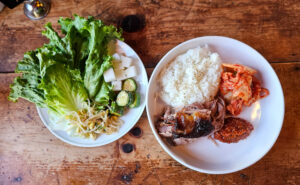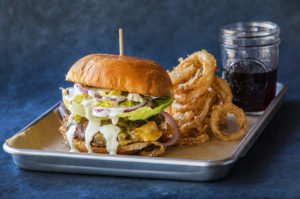 Yes, there’s something fishy happening all around us.
Yes, there’s something fishy happening all around us.
Peaking over the next few weeks, it’s salmon season. Though it runs from May through August, don’t be surprised to find everything from salmon soup and salmon cakes to perfectly grilled, seared and poached salmon popping up on menus and in grocery stores this summer. A culinary celebrity both for its rich flavor and health benefits, be forewarned that all salmon is not equal.
According to Monterey Bay Aquarium’s Seafood Watch, a highly regarded guide to sustainable seafood-eating, the most ocean-friendly salmon comes from Alaska, California, Oregon and Washington. It recommends avoiding salmon farmed in open net pens often called “Atlantic Salmon” in stores.
After several years of canceled seasons in California due to overfishing and ecological concerns, 2011 looks to be a banner year with record numbers of salmon returning to the rivers. When it comes to long-term sustainability, however, Chef John Ash says that “Alaska is the poster child for managing fish in the world.” Having just returned from an Alaskan adventure of teaching and fishing at Talon lodge, he’s seen up close the kind of careful monitoring of the salmon runs. “It’s written into their state constitution to provision sustainability,” said Ash.
Fish in your fridge is a ticking time bomb, and we all know it doesn’t get better with age. Here are some top notch ways to prepare your salmon…- A quick shout out to readers resulted in some terrific ideas: Cedar planked with pickled onions; olive oil poached with rosemary and wild fennel; grilled with lemon slices and dill; marinated with maple syrup and soy sauce; sashimi or with butter, garlic and mango salsa.- DIY Lox: It takes some doing, but you can either cold smoke (if you’re lucky enough to have a smoker) or salt-cure salmon steaks in the fridge and make your own lovely lox.
– Slow Roast: Chef John Ash recommends a slow roast in a 250-degree oven. Cook slowly to retain all of the juiciness.
– Sushi with caution: If you’re going raw, make sure your salmon has been frozen first. Most US sushi sold in restaurants has been flash frozen to kill off parasites and worms that are naturally prevalent in many fish. You’ll be fine if you just follow a bit of caution and make sure you’re buying from a reputable fish monger.
– Don’t mangle your Sockeye: Make sure you have a sharp boning knife if you’re going to do any cutting. Fish flesh is delicate, and will easily turn to mush if you man-handle it (trust me). Invest in a flexible boning knife if you can swing Sur La Table Culinary Instructor Mary Bergin recommends the Global 6-inch knife to her classes.
Fitting that bill is Taku River Reds, a family-run Alaskan fishing operation that’s co-owned by Sonoma County native and marine scientist Kirk Hardcastle. “Kirk knew at 10 that he wanted to be on the water,” said his father, Bob, who lives in Forestville. The senior Hardcastle picks up the Alaskan salmon each week at the Oakland Airport and distributes it to local fish markets including the venerable Monterey Fish Market in Berkelely. He can also be frequently found at Molsberry’s Market (522 Larkfield Center, Santa Rosa, 546-2331) handing out samples of the fish.
During the brief season, Kirk, along with his wife Heather and his in-laws manage thousands of pounds of weekly catches from eight contracted fishermen. The fish arrive at the dock around noon, are packed by 5pm and on the plane the following day, headed for restaurants from New York to Hawaii and on the table within 24 hours. Currently, Sockeye is at it’s peak season — the brightest colored salmon because of the krill and plankton it eats. Coho season starts in mid-August. Kind salmon runs from May through June.
While still on the boat, the fish are processed using a unique method called “pressure bleeding”which quickly drains the fish of blood, stalling the breakdown of the meat. They’re then placed in a seawater “slush” to cool the fish, painstakingly packaged to minimize damage. The result: Salmon that don’t smell fishy, have firm, moist flesh and taste like, well, what you think salmon should taste like.
Local chef devotees echo the sentiment. “This is the best quality salmon, just an incredible product,” said Cork’s Restaurant at Russian River Vineyards Chef Todd Davies. “And my dad is a salmon fisherman in Alaska. I’ll have their fish on my menu for as long as they’re catching fish,” he said. On Cork’s menu: Seared salmon with a saffron shellfish broth, mussels, lava beans and sea beans (5700 Gravenstein Highway North, Forestville, 887-3344). You’ll also find Taku River Salmon at the Farmhouse Inn (macadamia nut crusted with book choy, leeks and coconut lemongrass emulsion, 7871 River Road, Forestville, 887-3300); Korbel Winery Deli (13250 River Road, Guerneville, 824-7000), and John Ash & Co. (4330 Barnes Road, Santa Rosa, 527-7687). And if you have a Stanford student? Well, they’re eating Taku River Red’s as well. The university contracted for 20,000 pounds of fish this year.
Where else to find great salmon this season:
– Smoked Salmon: Nearly as precious as gold are the slices of smoked salmon from Santa Rosa Seafood (946 Santa Rosa Ave., 579-2085) at local farm markets. You’ll spend a pretty penny for these slices of carefully smoked local salmon, but it’s so worth it when you taste it. Sweet and addictive, locals call it “candy for adults”.
– Aioli Delicatessen: Tucked away in Forestville, Chef Autumn Barber serves wild King salmon from Bodega Bay with an herb crust, butter lettuce, poached baby red potatoes and cherry tomatoes with a whole grain mustard cream sauce each Wednesday and Thursday throughout salmon season. 6536 Front St, Forestville, 887-2476.
– Viola Pastry Cafe: Chef John Ash said one of his favorite recent salmon dishes was at this Santa Rosa cafe. On the dinner menu: Pan Seared salmon with summer a vegetable ragu. 709 Village Court, Santa Rosa, 544-8830.










